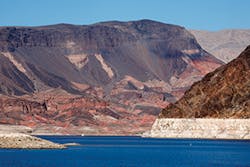“Being smart about how we grow and doing more with less” sums up the philosophy of the Las Vegas Valley Water District as it faces development in the Las Vegas Valley, according to Bronson Mack, a spokesman for the water district.
In the parts of the country such as the Las Vegas Valley, southern California, the area in east Texas around Austin, and parts of Oklahoma, drought creates additional pressures on water districts to guarantee water supply will be adequate for the next 50 years as residential and commercial developments expand.
Water conservation programs to reduce water use vary widely among the four water utilities covered here, depending on the severity of the drought in their areas. For example, the Las Vegas Valley, facing the most severe drought, uses water reuse to replenish its water source, but the other utilities do not.
Working With Developers
The review process for developers is similar in all of the municipal water utilities covered here. Talks between a developer of a master planned community and a water district may begin as much as two years before the first subdivision of the master plan receives approvals, and it begins in the planning department.
The first planned subdivision may be 3 miles away from a water source, so major facilities such as pumping stations and 42-inch pipes may have to be built. All must be operational, including connections to the water source, before the subdivision can be approved for construction, says Laura Jacobsen, a planner with the Las Vegas Water District. The reason is to provide fire protection capability, if needed, during construction.
Once boundaries are drawn by the developer, says Jacobsen, “We identify the pressure zones, or the range of elevations associated with the nearest water source. The pipes, once they are laid, must be able to maintain between 45 psi and 100 psi.
“A lot of the district’s work is determining what the demands the new development will have on the capacity of our distribution system,” she explains. The district may propose, for example, new facilities to be built to bring water from a reservoir to the development, she adds.
The developer will provide an engineering report that identifies the pipe sizing, the configuration of the subdivision, anticipated water demands, water pressure requirements, the water quality required, and fire flow capability, among other details. Negotiations between the developer’s engineering staff and the water district may take time to iron out the details.
Once the plans are approved, the developer files the final set of plans. In the case of the Las Vegas Valley Water District, it issues a water commitment that can be withdrawn if the developer does not advance the project, or if, at some future point, they disconnect water service. Construction can then begin.
The developer and engineering company designs and constructs the major facilities under the review of and inspection by the water district throughout the construction process to make sure they comply with state law. After a new section of pipe is laid and connected, the contractor must pressure test, chlorinate, and collect water samples for testing to make sure the pipe doesn’t leak and complies with safe water standards, says Jacobsen.
In the case of the Oklahoma City Utilities Department, it completes verification testing that includes hydrostatic and air testing, to make sure the pipes are water tight and comply with pressure requirements, according to Nathan Madenwald, a civil engineer with the Oklahoma City utilities department. A ball is pulled through the pipes to make sure the lines are fully open and then flushed with chlorinated water. Samples of water are taken over two days, and tested with multiple sampling protocols.
Once the tests are complete and approved, the water districts verify that all documents have GIS points in order, to guarantee they have a true record of where all pipes and valves are and to prevent others digging in those areas and damaging pipes. Only then can the contractor backfill the trenches and pave the roads.
Then, under a bill of sale, the developer turns over the new facilities to the water district. The only time this may not occur is when a property owner keeps ownership of the water distribution system if the entire development, such as an apartment house, is metered together.
